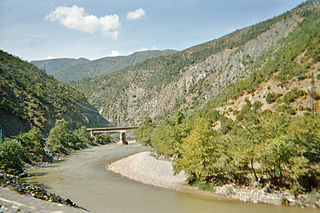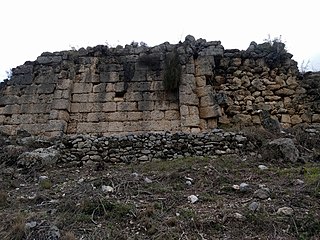This article relies largely or entirely on a single source .(April 2022) |
Eugenium was a village or fort of the Illyrian Parthini whose location is still unknown. [1]
This article relies largely or entirely on a single source .(April 2022) |
Eugenium was a village or fort of the Illyrian Parthini whose location is still unknown. [1]
Year 212 BC was a year of the pre-Julian Roman calendar. At the time it was known as the Year of the Consulship of Flaccus and Pulcher. The denomination 212 BC for this year has been used since the early medieval period, when the Anno Domini calendar era became the prevalent method in Europe for naming years.
Year 215 BC was a year of the pre-Julian Roman calendar. At the time it was known as the Year of the Consulship of Albinus/Marcellus/Verrucosus and Gracchus. The denomination 215 BC for this year has been used since the early medieval period, when the Anno Domini calendar era became the prevalent method in Europe for naming years.
The Illyrian Wars were a series of wars fought between the Roman Republic and the Ardiaei kingdom. In the First Illyrian War, which lasted from 229 BC to 228 BC, Rome's concern was that the trade across the Adriatic Sea increased after the First Punic War at a time when Ardiaei power increased under queen Teuta. Attacks on trading vessels of Rome's Italic allies by Illyrian pirates and the death of a Roman envoy named Coruncanius on Teuta's orders, prompted the Roman senate to dispatch a Roman army under the command of the consuls Lucius Postumius Albinus and Gnaeus Fulvius Centumalus. Rome expelled Illyrian garrisons from a number of Greek cities including Epidamnus, Apollonia, Corcyra, Pharos and established a protectorate over these Greek towns. The Romans also set up Demetrius of Pharos as a power in Illyria to counterbalance the power of Teuta.
Taulantii or Taulantians were an Illyrian people that lived on the Adriatic coast of southern Illyria. They dominated at various times much of the plain between the rivers Drin (Drilon) and Vjosa (Aoös). Their central area was the hinterland of Epidamnos-Dyrrhachion, corresponding to present-day Tirana and the region between the valleys of Mat and Shkumbin (Genusus). The Taulantii are among the oldest attested Illyrian peoples, who established a powerful kingdom in southern Illyria. They are among the peoples who most marked Illyrian history, and thus found their place in the numerous works of historians in classical antiquity.

Apollonia was an Ancient Greek trade colony which developed into an independent polis, and later a Roman city in southern Illyria in classical antiquity. It was located on the right bank of the Aoös/Vjosë river, approximately 10 km from the eastern coast of the Adriatic Sea. Its ruins are situated in the county of Fier, close to the village of Pojan, in Albania.
Demetrius of Pharos was a ruler of Pharos involved in the First Illyrian War, after which he ruled a portion of the Illyrian Adriatic coast on behalf of the Romans, as a client king.

The Shkumbin, also commonly Shkembi, is a river in Southern Europe. It is 181 km (112 mi) long and its drainage basin is 2,444 km2 (944 sq mi). Its average discharge is 61.5 m3/s (2,170 cu ft/s).
Scerdilaidas or Skerdilaid was an Illyrian ruler of the Illyrian kingdom under the Labeatan dynasty. Before taking the throne, Scerdilaidas was commander of the Illyrian armies and played a major role in the Illyrian Wars against the Romans.
Dimale or Dimallum was a town in southern Illyria in classical antiquity which was situated in the vicinity or within the territory of the Parthini, an Illyrian tribe. It was built on a hill of 450 m above sea level, in the hinterland of Apollonia, about 30 km from the eastern coast of the Adriatic. It is located in today Krotinë, Berat County, Albania.
The Parthini, Partini or Partheni were an Illyrian tribe that lived in the inlands of southern Illyria. They likely were located in the Shkumbin valley controlling the important route between the Adriatic Sea and Macedonia, which corresponded to the Via Egnatia of Roman times. Consequently, their neighbours to the west were the Taulantii and to the east the Dassaretii in the region of Lychnidus.
Bassania was an Illyrian city that came under Roman control during the Illyrian Wars. It was located close to the ancient city of Lissus in southern Illyria, modern Albania. The inhabitants of the city were called Bassanitae. The time when the Bassanitae became socii of the Romans is still unknown.
The Dassareti were an Illyrian people that lived in the inlands of southern Illyria, between present-day south-eastern Albania and south-western North Macedonia. Their territory included the entire region between the rivers Asamus and Eordaicus, the plateau of Korça locked by the fortress of Pelion and, towards the north it extended to Lake Lychnidus up to the Black Drin. They were directly in contact with the regions of Orestis and Lynkestis of Upper Macedonia. Their chief city was Lychnidos, located on the edge of the lake of the same name.
Parthus or Parthos was a settlement of the Illyrian tribe of the Parthini in southern Illyria, modern Albania. Although different sites in central Albania have been proposed, its exact location has not yet been found.

The Labeatae, Labeatai or Labeates were an Illyrian people that lived on the Adriatic coast of southern Illyria, between modern Albania and Montenegro, around Lake Scodra.
Bargulum was a settlement of the Illyrian tribe of the Parthini in southern Illyria, modern Albania. Its exact location is still unknown.
Atintanes or Atintanians was an ancient tribe that dwelled in the borderlands between Epirus and Illyria, in an inland region which was called Atintania. They have been described as either an Epirote tribe that belonged to the northwestern Greek group, or as an Illyrian tribe. They were occasionally subordinate to the Molossians.
Sesarethus was an ancient city in southern Illyria. Stephanus of Byzantium from the 6th century AD reports, citing Hecataeus, that Sesarethos was a Taulantian city, and that Sesarethioi was its ethnicon. The city and the tribal name Sessarethes have been related by modern scholars to the Illyrian tribe of Dassaretii. The variant Sesarethii is also mentioned by Strabo as an alternative name of the Enchelei.
Pleuratus III was a ruler of the Illyrian kingdom under the Labeatan dynasty. He was the son of Scerdilaidas. Pleuratus continued his father's pro-Roman policy even more decidedly, so much that his loyalty to Rome was well known, even to other dynasts. He managed to extend the boundaries of the Illyrian State in the south when he was rewarded land annexed by Philip V of Macedon. He became one of the most prominent Illyrian kings of the time all because of his loyalty to the Romans. Pleuratus was succeeded by his son Gentius, who was the last Illyrian king.

The Persqopi Castle is a 4th century BC era Illyrian ancient city, located near modern Tirana, Albania.
The Penestae were an Illyrian tribe dwelling in southeastern Illyria, in an inland region that was called Penestia, which was located around the Black Drin valley north of Lake Ohrid, between present-day eastern Albania and western North Macedonia. They are firstly mentioned by ancient Roman historian Livy. They appear several times in Livy's accounts of the events concerning the Third Macedonian War, which was fought between the Roman Republic and the Kingdom of Macedonia under Perseus. Their chief city was Uscana, most likely located in the valley of the Black Drin in the region of Dibra.